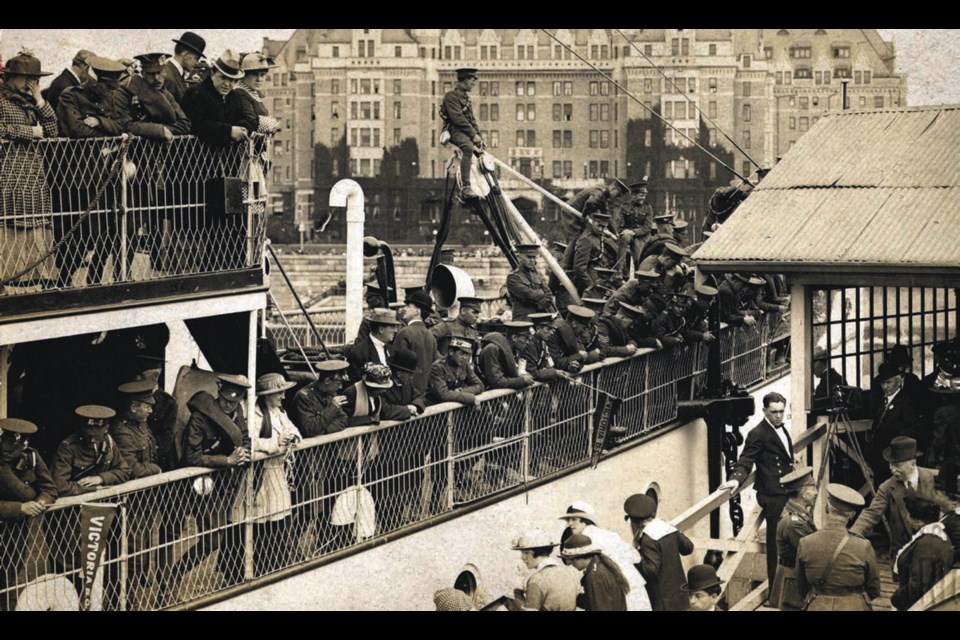The Canadian Scottish Regiment is forming a funeral party to fly to France and lay to rest three soldiers who died at the Battle of Hill 70, one of the Canadian Army’s formative engagements of the First World War.
The 31 members of the casket party, mostly from Victoria, are rehearsing at the Bay Street Armoury in time for the Aug. 23 ceremony. They will bury the recently discovered remains of three men: Pte. William Donegan, Pte. Henry Priddle and Sgt. Archibald Wilson at the Loos British Cemetery.
All three men died at the Battle of Hill 70, Aug. 15 to 25, 1917. All three were among the remains of 31 Canadian soldiers recovered during an excavation near Lens, France.
Canadian Scottish Sgt. Glen Ereaut, drum major with the regimental band, will be a member of the casket party and will bring back for the regimental museum items of the wartime kits carried by the three.
Ereaut called it an honour to be included in the casket party.
“We are going to be putting three caskets in the ground,” he said. “But there is a very thick manual for funerals in the military, and that’s what is giving us direction.”
All three First World War soldiers were identified through analysis of DNA extracted from the remains. It’s an ongoing analysis undertaken by the history and heritage branch of the Department of National Defence, which requests and collects samples from living relatives to compare and positively make the ID.
Jim Kempling, a Victoria historian specializing in the First World War, said the Battle of Hill 70 can be regarded as the most important fight of the First World War to be undertaken by the Canadian Corps.
Kempling said Vimy Ridge, in April 1917, gets the most recognition as Canada’s first real military victory. The four divisions of the Canadian Corps fought together for the first time at Vimy. But in overall command was Lt. Gen. Sir Julian Byng, a British officer.
Hill 70, however, was the first time Canadians fought together as Canadians, commanded by Canadian officers in a battle plan drawn up by a Canadian general, Lt. Gen. Arthur Currie, who enlisted in Victoria.
Kempling said from early on, Currie distinguished himself by standing up to the British high command. Ordered to have the Canadian Corps take the French city of Lens, Currie objected to the notion of attacking a city.
Attacking a city “is always a nasty business,” he said. “There’s lots of places to set up defensive positions behind brick walls, in cellars, there’s lots of places for booby traps and you are confined to narrow streets and alleys with buildings looking down on you.”
So Currie looked at topographical maps and noted a high point north of Lens. If Canadians took it, the Germans, still lodged in Lens, would be at the mercy of Canadian big guns. The Germans would have two choices: Leave Lens or counterattack and retake the hill.
That piece of ground, according to the topographical maps, was 70 metres above sea level, earning it the name Hill 70
Kempling said it all went as Currie foresaw and commanded. The Canadian Corps took Hill 70. Canadian engineers quickly oversaw its transformation into a defensive redoubt. German troops attacked many times and were beaten back each time.
“Currie and the Canadian Corps really distinguished themselves there,” said Kempling.
Beyond the scientific analysis and the understanding of the Battle of Hill 70, finding the personal paths walked by the three men took some sleuthing by historians and museum specialists. Tracing their connection to the Canadian Scottish Regiment, now based in Victoria, meant following paper trails laid down by Canadian army bureaucracy.
Jack Drysdale, assistant director of the Canadian Scottish Regimental Museum, explained that the early Canadian enlistees in the First World War signed up for local regiments that were later organized into numbered groups.
The Gordon Highlanders, raised in Victoria, were amalgamated with the Vancouver-raised Seaforth Highlanders, the Cameron Highlanders of Winnipeg and the Argyll and Sutherland Highlanders of Hamilton, Ont. Together they became the 16th Battalion of the 1st Canadian Division.
But people, including the men of the 16th Battalion, simply starting calling themselves “The Canadian Scottish,” a name that wasn’t made official until after the war.
Drysdale said that by 1917, most of the reinforcements for the Canadian Scottish were from the Prairies.
Donegan and Wilson were both Cameron Highlanders out of Winnipeg. Priddle also signed up in Winnipeg, with the 183rd (Manitoba Beavers) Battalion and was later enrolled in the 16th Battalion. It was all done whether the men liked it or not.
“They were almost guaranteed they could enlist and travel overseas and fight beside their pals,” said Drysdale. “When they got there, they were told: ‘We’re breaking up the unit because this battalion or that battalion needs reinforcements.’”
He said historical records reveal the battle plans and lines of attack laid out for the various army groups, including the 16th Battalion, which offered another clue to help in the identification of the dead soldiers.
None of the bodies were recovered at the time, and their remains were covered by the explosions and mud of battle, probably close to where they died following the paths laid down by their superiors.
For Drysdale, fortunate discoveries from the excavations in France are the personal items: Donegan’s wristwatch, a shovel carried by Wilson and a bottle of iodine, still full, belonging to Priddle.
“It’s neat to actually see things like that,” he said. “Items like these are personal and give you a connection to an actual person.”



